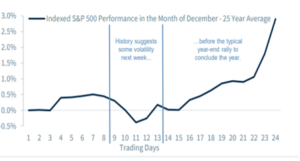Historically December has been a strong month for the markets with the S&P 500 experiencing a gain 73% of the time since 1928. As shown in the chart below, typically, the month ends with a phenomenon known as the Santa Clause rally, which sees stock prices rise in the last five trading days of December and into the first two days of January.
This year, December has seen a bit more volatility than we have previously experienced as we continue to navigate the newest COVID variant, the effects of increased inflation on the economy, and the Federal Reserve’s inevitable reduction in stimulus.
As we approach the second anniversary of the pandemic, we are reminded that the virus remains in charge and a risk to the global economy. The World Health Organization designated a new strain of COVID known as Omicron. Though seemingly not as lethal as previous variants, Omicron looks to be more contagious than its predecessors. The news initially caused a sharp drop in the financial markets but later rebounded as we headed deeper into December. With little political will to enact more COVID restrictions, the S&P 500 recorded its best weekly gain since February as fears seemed to subside about the new variant. Nevertheless, additional flare-ups of the virus will continue to impact global travel, manufacturing, and supply chain. As such, the virus remains a risk to economic growth and inflation.
Seemingly conflicting economic data also contributed to the volatility seen in December. While the Labor Department reported the lowest number of Americans applying for unemployment benefits since 1969, as well as a record 11 million job vacancies, the consumer price index—a measure of inflation—rose by 6.8% on a year-over-year basis. This is the biggest jump since 1982. Rising energy costs are a key factor in the inflation numbers, but consumers are experiencing a broad-based increase in prices. Everything from food and housing to transportation and medical care have experienced higher prices.
Spurred by the inflation numbers, on December 15 the Federal Reserve announced that it will be doubling the pace of tapering which will conclude in March 2022. At that time, the Fed will no longer be adding to its balance sheet. They also anticipate three 25-basis-point increases in the Fed funds rate next year, moving up from essentially zero where the rate has been since March 2020. With this move in monetary policy, the Federal Reserve hopes to decrease inflation which it sees as a major hurdle in an otherwise strong economy. Coupled with the debt-ceiling limit being raised by Congress, it appears that some uncertainty has been removed from the market, which investors tend to favor.
FSA continues to be mostly fully invested across all our strategies, although a few individual funds have tripped through the FSA Safety Net® and were sold or replaced. We will continue to monitor the market trends for changes that may affect the portfolio allocations.
We have much to be thankful for in 2021, including your trust and confidence in us. We wish you happy holidays and Merry Christmas and a great start to the New Year.
Myennohweh McCurrie, CFP®
Financial Advisor
Disclosures are available at https://fsainvest.com/disclosures/market-update/.
FSA’s current written Disclosure Brochure and Privacy Notice discussing our current advisory services and fees is also available at https://fsainvest.com/disclosures/ or by calling 301-949-7300.





